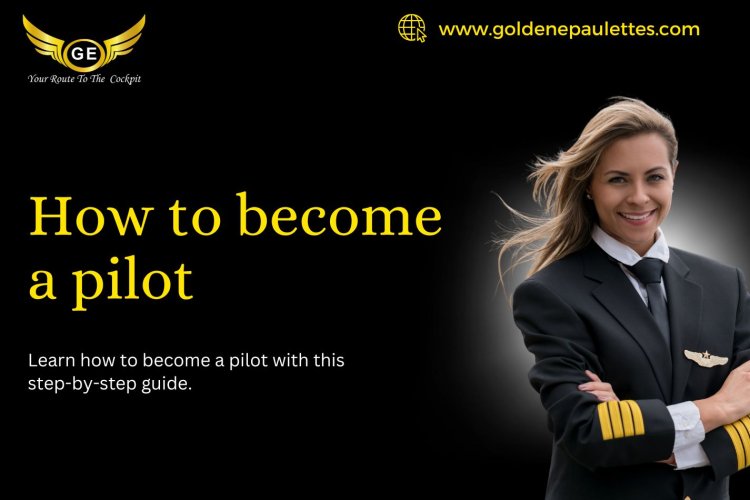Pilot Career Progression: From First Officer to Captain
Becoming a pilot is a dream career for many aviation enthusiasts

Pilot Career Progression: From First Officer to Captain
Introduction
Becoming a pilot is a dream career for many aviation enthusiasts. The journey to the cockpit is both exciting and challenging, requiring dedication, training, and experience. From starting as a student pilot to earning the rank of captain, the progression in this field follows a structured path. If you are wondering howtobecomepilot, this guide will help you understand the career stages and the requirements to reach the top of the aviation industry.
Step 1: Getting a Private Pilot License (PPL)
The first step in a pilot’s career progression is obtaining a Private Pilot License (PPL). This allows aspiring pilots to fly aircraft for leisure or non-commercial purposes. Here’s what you need:
-
Minimum Age: 17 years
-
Medical Certificate: Class 2 medical clearance
-
Flight Hours: Around 40-50 hours of flight training
-
Written Exam: A theoretical knowledge test
-
Flight Test: Practical examination with a certified examiner
A PPL is the foundation for all advanced pilot training, helping students understand aerodynamics, navigation, and flight controls.
Step 2: Obtaining a Commercial Pilot License (CPL)
To pursue a career in commercial aviation, one must obtain a Commercial Pilot License (CPL). This license allows pilots to work for airlines, cargo carriers, and private charters. The CPL training includes:
-
Minimum Age: 18 years
-
Medical Certificate: Class 1 medical clearance
-
Flight Hours: At least 200 hours of flight experience
-
Advanced Maneuvers: Night flying, cross-country flights, and instrument flying
-
Written Exams & Check Ride: Testing on air law, meteorology, navigation, and practical skills
A CPL holder can work as a co-pilot in smaller aircraft or as a flight instructor to gain further experience.
Step 3: Gaining an Airline Transport Pilot License (ATPL)
The Airline Transport Pilot License (ATPL) is the highest level of certification for commercial pilots. It qualifies a pilot to operate as a captain in commercial airlines. The requirements include:
-
Minimum Age: 23 years
-
Flight Hours: 1,500+ hours of total flight time
-
Additional Training: Multi-crew cooperation (MCC), jet transition training, and simulator-based exercises
-
Written Exam & Check Ride: Advanced testing in flight planning, aviation law, human performance, and more
An ATPL is initially issued as a Frozen ATPL, meaning the pilot meets theoretical requirements but must gain further flight experience before becoming a captain.
Step 4: Becoming a First Officer
A First Officer, commonly known as a co-pilot, is the second-in-command in an aircraft. They assist the captain in operations and decision-making. Responsibilities include:
-
Assisting with flight planning and navigation
-
Communicating with air traffic control (ATC)
-
Monitoring aircraft systems and handling emergency situations
-
Supporting the captain in all aspects of flight
First Officers typically start their careers with regional airlines or cargo carriers before progressing to major airlines. The experience gained in this role is crucial for future promotions.
Step 5: Achieving the Rank of Captain
After accumulating substantial flight hours and proving competence, a First Officer is eligible for promotion to Captain. This position comes with greater responsibilities and requires exceptional decision-making skills. To qualify as a captain, pilots must:
-
Accumulate at least 3,000–4,000 flight hours (varies by airline)
-
Demonstrate strong leadership and teamwork skills
-
Pass additional simulator evaluations and command training
-
Exhibit excellent problem-solving and crisis management abilities
Captains are responsible for the overall safety of the flight, crew, and passengers. They make critical decisions during emergencies and ensure compliance with aviation regulations.
Career Growth Beyond Captain
For pilots looking for further career advancement, several opportunities exist beyond the captain's role:
-
Chief Pilot: Oversees airline operations and ensures compliance with aviation regulations
-
Flight Instructor: Trains aspiring pilots in flight schools or airline academies
-
Examiner or Check Airman: Evaluates other pilots’ performance and conducts certification tests
-
Airline Operations Manager: Works in airline management, overseeing schedules, safety, and logistics
Challenges & Rewards in a Pilot’s Career
Becoming a commercial airline pilot requires dedication, but it offers a fulfilling and financially rewarding career. Some challenges include:
-
Extensive Training: Completing thousands of flight hours requires time and investment
-
Work-Life Balance: Pilots often work irregular hours, including weekends and holidays
-
Responsibility: Ensuring passenger safety under all conditions is a critical duty
Despite these challenges, the rewards of a pilot’s career include competitive salaries,howtobecomepilot travel perks, and the thrill of flying high-tech aircraft.
Conclusion
The journey from a First Officer to a Captain is an exciting and structured process. If you are searching for howtobecomepilot, start by obtaining the necessary licenses, gaining flight experience, and continuously improving your skills. With dedication and passion, you can achieve the dream of commanding an aircraft as a commercial airline captain.
What's Your Reaction?


















.jpg)
